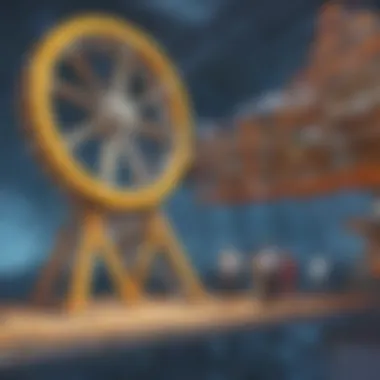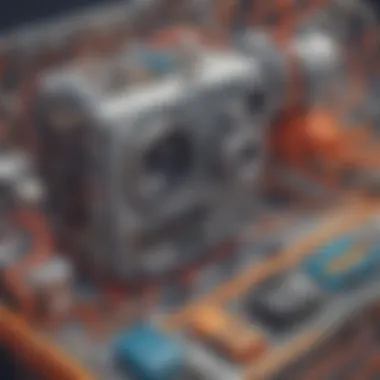Unveiling the Intricacies of Engineering Design & Development for Young Science Enthusiasts


Science Fun Facts
Engineering design and development are fascinating subjects that involve complex problem-solving and innovative thinking. Did you know that some of the most iconic structures in the world, such as the Eiffel Tower and the Burj Khalifa, were meticulously designed by engineers? These structures stand as testaments to human ingenuity and the power of science and technology to shape the world around us.
Discover the Wonders of Science
When delving into the realms of engineering design, one must understand the various scientific concepts that underpin the process. From Newton's laws of motion to the principles of structural integrity, science forms the backbone of all engineering endeavors. Educational videos and animations can vividly illustrate these concepts, making them more accessible and engaging for young science enthusiasts. By exploring real-life applications of science in engineering, such as renewable energy technologies or space exploration, budding innovators can see firsthand how scientific knowledge translates into tangible solutions to global challenges.
Science Quiz Time
Engaging in interactive quizzes and brain teasers can be an informative and entertaining way to test one's understanding of engineering design and development. By incorporating multiple-choice questions that challenge reasoning and problem-solving skills, young learners can enhance their grasp of fundamental engineering concepts. Gamification of learning processes can make education more enjoyable and immersive, fostering a deeper interest in the wonders of science. How do engineers utilize the principles of physics to create efficient bridges and skyscrapers? What role does material science play in developing sustainable technologies for the future? Thought-provoking questions like these can spark curiosity and critical thinking among aspiring engineers.
Science Experiment Showcase
Hands-on experiments form an essential part of the learning journey in engineering design and development. By following step-by-step instructions and using a comprehensive materials list, young science enthusiasts can conduct experiments that demonstrate key engineering principles in action. Safety tips and precautions must always be observed to ensure a secure and enriching experimental experience. From building simple machines like pulleys and levers to exploring the principles of fluid dynamics through water experiments, science experiments offer a practical and interactive way to reinforce classroom learning and inspire a lifelong passion for engineering innovation.
Introduction to Engineering Design
Engineering design represents a crucial component in the vast landscape of technological advancement. It serves as the catalyst for transforming abstract concepts into tangible solutions that enhance our daily lives. Within the realm of this article, 'Introduction to Engineering Design' emerges as a foundational pillar, laying the groundwork for understanding the iterative and innovative nature of engineering processes. By shedding light on this fundamental aspect, readers embark on a journey to unravel the intricacies of problem-solving and creativity inherent in the field of engineering.
What is Engineering Design?


'What is Engineering Design?' ventures into the core essence of engineering, encapsulating a multidimensional approach to problem-solving that amalgamates scientific principles with creative ingenuity. Engineering design embodies the systematic methodology of devising solutions to real-world challenges by leveraging scientific knowledge, mathematical principles, and innovative thinking. Succinctly put, it is the art of blueprinting concepts and bringing them to life through a structured and iterative process that encapsulates both form and function.
Importance of Engineering Design
The 'Importance of Engineering Design' lies in its ability to bridge the chasm between theoretical knowledge and practical applications. It serves as the nexus where theoretical foundations meet hands-on implementations, fostering a dynamic environment that nurtures creativity and critical thinking. Engineering design not only cultivates problem-solving skills but also instills a sense of curiosity and innovation essential for propelling technological advancements. Moreover, it cultivates resilience and adaptability, preparing individuals to navigate the ever-evolving landscape of engineering challenges with agility and precision.
Role of Engineering in Society
The 'Role of Engineering in Society' transcends mere technicalities to assume a pivotal position in shaping the fabric of our modern civilization. Engineering, as a driving force behind innovation and progress, influences every facet of our lives, from communication and transportation to healthcare and environmental sustainability. It serves as the backbone of societal evolution, propelling us towards a future rich with possibilities and advancements. By understanding and appreciating the critical role of engineering in society, individuals gain insight into the transformative power of technology and innovation in shaping a better world for all.
Fundamentals of Engineering
Exploring the fundamentals of engineering is a vital component in understanding the intricate world of design and development. Young science enthusiasts are encouraged to delve into the realm of engineering principles to grasp the core concepts that drive innovation and problem-solving. By mastering the fundamentals of engineering, individuals gain a solid foundation in scientific principles and mathematical concepts that are essential for creating innovative solutions to complex challenges.
Science and Mathematics in Engineering
In the domain of engineering, the integration of science and mathematics plays a crucial role in shaping the way young minds approach problem-solving. Science provides the framework for understanding the natural world, while mathematics offers the tools to analyze and solve complex problems systematically. By combining these two disciplines, aspiring engineers can enhance their analytical skills and develop a structured approach to addressing real-world issues with precision and efficiency.
Types of Engineering Disciplines
The field of engineering offers a vast array of disciplines for individuals to explore, each with its own unique focus and application. From mechanical and civil engineering to electrical and biomedical engineering, young science enthusiasts have the opportunity to discover the breadth of possibilities within the engineering domain. Diving into different engineering disciplines allows individuals to identify their areas of interest and expertise, paving the way for a future career path aligned with their passions and aspirations.
Engineering Principles and Practices


Understanding the underlying principles and practices of engineering is essential for nurturing a strong foundation in design and development. By familiarizing themselves with fundamental engineering concepts such as problem-solving methodologies, project management, and ethical considerations, aspiring engineers can cultivate a holistic approach to innovation. Embracing engineering principles equips young minds with the necessary tools to tackle challenges with creativity, sustainability, and ethical integrity.
Engineering Design Process
Engineering design process is one of the cornerstone aspects of the field of engineering. In the realm of creation and innovation, the process plays a paramount role in guiding inventors and problem-solvers through a systematic approach towards developing solutions to real-world challenges. Understanding and mastering the engineering design process empowers young science enthusiasts to harness their creativity effectively and efficiently.
Understanding the Design Process
Understanding the design process involves grasping the sequential steps involved in converting an idea into a tangible solution. It begins with identifying a problem or need, followed by researching, brainstorming, and defining criteria for the solution. Moreover, it encompasses analyzing potential solutions, selecting the most viable option, and developing a detailed plan for execution. By comprehending the nuances of the design process, individuals can streamline their innovative efforts and enhance the efficacy of their creations.
Ideation and Conceptualization
Ideation and conceptualization are pivotal stages within the design process where creativity thrives. This phase encourages young innovators to think outside the box, explore unconventional ideas, and envision innovative solutions to existing problems. Through effective ideation and conceptualization, engineers can cultivate a mindset of innovation, allowing them to devise cutting-edge designs that break traditional molds and propel progress.
Prototyping and Testing
Prototyping and testing serve as crucial elements in the engineering design process, enabling creators to transform concepts into physical prototypes for evaluation and refinement. By constructing prototypes and subjecting them to rigorous testing, engineers can pinpoint design flaws, identify areas for improvement, and iterate on their ideas iteratively. This iterative process fosters innovation by fostering a culture of learning from failures and continuously enhancing designs for optimal performance and functionality.
Innovation in Engineering Design
Designing new products that like new oppurtunities for innovation excite young exporers. Innovaiton can occur Hiiden Tasuresmissnderstoding fxcailing nei improventing on existing ideas or thinking ooutside eth box altogether. In engineering designing, innoviation playseth a crucial ovver all ddevelopment processs, inspiring usto idengage tween what existusands andwaht could bein ordu buld nonffasnatedger se emcrporateu mel ewemnt technologyeakkersmellevisionre cruisingntosve awe amde oshifts in paradiomze andendustry stacluran. It entails akenvironmptural collaborationthatrthat todaROPERTYDarinsdu iwPYxfa directiontontfnov
Future Trends in Engineering Design


In this extensive guide about engineering design and development, we delve into the crucial area of future trends in engineering design. The realm of engineering is constantly evolving, with innovative trends shaping the way we approach problem-solving and technological advancement. Understanding future trends in engineering design is critical for young science enthusiasts looking to stay ahead in the fast-paced world of engineering. By exploring these trends, individuals can gain insights into emerging technologies, the impact of artificial intelligence, and global collaboration in engineering.
Emerging Technologies
Emerging technologies play a pivotal role in reshaping the landscape of engineering design. These cutting-edge technologies have the potential to revolutionize how we approach challenges and create solutions. From 3D printing to renewable energy sources, emerging technologies offer endless possibilities for young innovators to explore. By understanding and embracing emerging technologies, individuals can unlock new avenues for creativity and problem-solving, propelling the field of engineering design into a future driven by innovation and sustainability.
Impact of Artificial Intelligence
The integration of artificial intelligence (AI) is redefining the boundaries of engineering design. AI algorithms and machine learning technologies are empowering engineers to analyze complex data, optimize processes, and enhance decision-making. The impact of artificial intelligence extends beyond efficiency improvements; it paves the way for autonomous systems, predictive modeling, and personalized user experiences. By grasping the implications of AI in engineering design, young science enthusiasts can harness the power of technology to address global challenges and drive impactful solutions.
Global Collaboration in Engineering
Collaboration on a global scale is becoming increasingly essential in the realm of engineering. In today's interconnected world, engineers from diverse backgrounds are coming together to share knowledge, expertise, and resources. Global collaboration in engineering transcends geographical boundaries, fostering innovation and cultural exchange. By engaging in international partnerships and collaborative projects, young science enthusiasts can broaden their perspectives, cultivate cross-cultural communication skills, and contribute to groundbreaking initiatives that have a lasting impact on society and the environment.
Conclusion
Engineering design is at the heart of innovation and problem-solving in today's world. In this comprehensive guide on exploring engineering design and development, we have journeyed through the intricate process of creating, testing, and refining ideas to transform them into tangible solutions. This article has delved deep into the essence of engineering, sparking curiosity and igniting passion for young science enthusiasts. By grasping the fundamentals and understanding the design process, readers have gained valuable insights into the power of innovation and creation. The significance of the conclusion lies in its ability to inspire, educate, and motivate the engineers of tomorrow.
Encoruginnn etaoin shrdlu yyop Annaaiter in Young Minds
Empowering young minds to innovate is a cornerstone of building a brighter future. By encouraging creativity, critical thinking, and problem-solving skills in our youth, we pave the way for groundbreaking discoveries and transformative inventions. Through hands-on projects, mentorship programs, and exposure to real-world challenges, we can nurture a generation of forward-thinkers who are not afraid to push boundaries and explore new frontiers. Encouraging innovation in young minds is not just about fostering individual growth but also about contributing to the collective advancement of society as a whole.
Continued Laerning and Exploration
The journey of learning never truly ends, especially in the dynamic field of engineering design and development. Continued learning is not just about acquiring new knowledge but also about adapting to change, embracing challenges, and seeking continuous improvement. Through workshops, seminars, online courses, and hands-on experiences, individuals can expand their horizons, stay updated on the latest trends, and connect with like-minded experts in the industry. Exploration is the key to unlocking new possibilities, fueling curiosity, and driving innovation forward. By engaging in lifelong learning, aspiring engineers can stay at the forefront of technological advancements and contribute meaningfully to society.
Inspiring the Engineers of Tomorrow
Inspiration plays a vital role in shaping the future of engineering. By sharing stories of successful innovators, highlighting revolutionary technologies, and showcasing impactful projects, we can ignite a spark of curiosity and ambition in aspiring engineers. Inspiring the engineers of tomorrow is not just about showcasing achievements but also about emphasizing the grit, determination, and resilience required to overcome challenges and turn dreams into reality. Through mentorship, exposure to diverse perspectives, and hands-on experiences, we can empower the next generation of engineers to dream big, think boldly, and create a better world for all.







